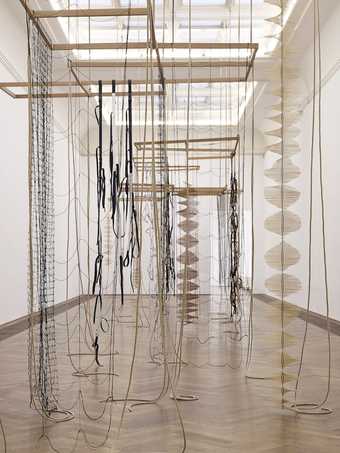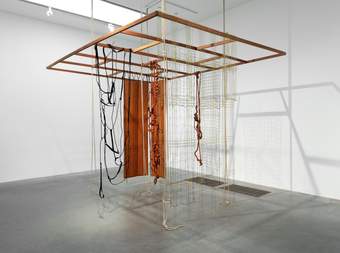
View of the exhibition Anni Albers Textiles at the Museum of Modern Art, New York, 1949, photographed by Soichi Sunami
Image © 2015 MoMA, NY

View of the exhibition Leonor Antunes: the last days in Chimalistac at Kunsthalle Basel, 2013
Courtesy Leonor Antunes and Kunsthalle Basel, photo: Nick Ash
I first started to think deeply about Anni Albers’s work when I travelled to Mexico City in 2007. I rented an apartment in the city centre and spent a lot of time at the National Autonomous University of Mexico, where I researched the archive of Clara Porset, a designer who spent the last years of her life teaching in the university’s Architecture Department. Although she had lived in Mexico City, Porset was Cuban, and, as a communist and activist, had seen a lot of her commissions refused in Mexico, where the very few pieces she made went largely unappreciated. (Mexican architect and engineer Luis Barragán even stopped collaborating with her.) Porset, I discovered, had studied with Josef Albers at Black Mountain College. There she developed a friendship with him and Anni, and would be responsible for bringing the couple to Mexico.
In 2011, my connection to Anni Albers and her work was strengthened when I made an exhibition at Kunsthalle Basel that centred indirectly around the figure of Clara Porset, exploring both the figures who had influenced her and those whom I had linked to her. The exhibition was titled the last days in Chimalistac and the poster showed Clara Porset sitting with her dog in the backyard of her home in Chimalistac, an area of Mexico City. I showed a group of sculptures that were literal translations of Anni Albers’s weavings, using tubes and wire, at a scale of 1:1. For these I decided to use only the weavings she made after she started travelling to South America – Mexico, in particular.
When Anni Albers began her studies at the Bauhaus, it hadn’t been her intention to join the weaving department, but, as a woman, she was barred from attending the architecture classes. She used this restriction as a tool, however, becoming a prolific researcher with an avid curiosity that is, to me, reminiscent of an archaeologist. Her work is encyclopaedic. She studied ancient and archaic ways of weaving, but found a way of linking this knowledge to the modern language of architecture and urbanism. It’s rare to see an artist that has done so much research into an area and yet is able to physically explore it so freely. She is a maker, and her work does not reveal a nostalgia for a world before modernism but creates a legacy – a belief in art as an ongoing engagement in a process, rather than a singular object of a frozen utopian moment.
Leonor Antunes is an artist living and working in Berlin and Lisbon. Leonor Antunes: the last days in Galliate, Pirelli HangarBicocca, Milan, 14 September – 13 January 2019.

